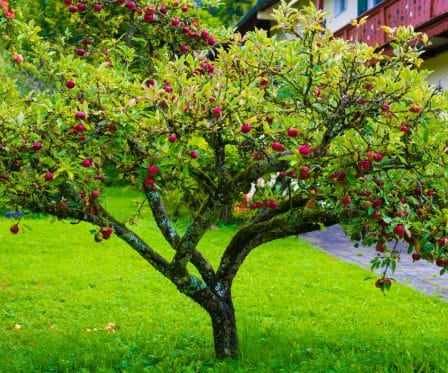
When selecting the best fruit trees to grow in Portland, homeowners are opting for more natural-looking landscaping rather than the pristine trimmed grass that has long been a staple in landscaping across the United States. Instead, they’d rather diversify their landscaping by choosing plants and trees that are already local to the environment. The best way that homeowners have done this is by incorporating the natural beauty and bounty of Oregon’s fruit trees. Even adding one or two fruit trees to the front yard, back yard, or side yard can boost the aesthetic of the home easily, as well as provide fruits for the homeowner and their family to enjoy. According to the Arbor Day Foundation, simply adding a few trees to the landscaping surrounding a home can boost the home’s value by up to 15%. Additionally, they state that 5 years after planting a tree on the west side of the home, homeowners can expect to see their energy costs lower by about 3%.
Not only do fruit trees provide a comfortable and warming ambiance to the outdoor spaces surrounding the home, but they are also very beneficial to the environment. The Arbor Day Foundation states that when trees are properly planted around a building, air conditioning needs can be lowered by 30%. It also saves money in the long run with an expected savings of up to 50% on heating and energy costs. Planting trees along the home is also a great way to prevent erosion and runoff. This is mainly due to the fact that trees improve water quality, which in turn helps deter erosion and lessen water runoff.
Many homeowners wish to have more wildlife visit their yards, and fruit trees are the perfect attractant. A plethora of bird species, deer, bears, elk, and even moose love the opportunity to have a deliciously sweet meal. Wildlife in Portland will also utilize the nuts, buds, sap, rotten fruit, and bark as a source of nutrition when preparing for the winter months. Those who love wildlife will be thrilled to see the diversity in animals that choose to frequent their fruit trees.
It’s easy to see how beneficial planting fruit trees are when looking at their economic and environmental benefits. The hardest part is choosing which fruit trees to plant, and which fruit trees will succeed in bearing fruit in your specific location. Our main goal at Urban Forest Pro is to provide all our clients with all the information our ISA Certified Arborists have to offer in the Portland area. Our high-quality tree services have made us one of the best with over 15 years of experience. Therefore we have compiled a list of the top six fruit trees to plant in Portland. Here are our picks!
6 Fruit Trees That Thrive in Portland, Oregon
When choosing fruit trees to add to a home’s landscaping, it’s important to choose fruit trees that will blossom in Portland’s unique climate. Fortunately, there are many types of fruits with varieties that flourish in Portland’s weather year-round.
1. Apple Trees
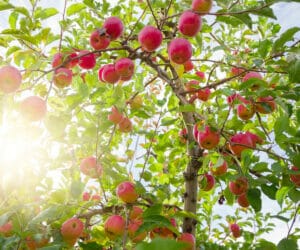
Apple trees are one of the best fruit trees to grow in Portland. Many varieties of apple trees thrive in wet and mild climates, which makes Portland perfect. In fact, over 125 million pounds of apples are harvested every year in Oregon, mainly due to the perfect climate. There are over 2,500 varieties of apple trees to choose from, and most of them thrive in Portland’s climate. The best apple varieties to grow in Portland are:
- Fuji
- Honeycrisp
- Gala
- Braeburn
- Granny Smith
- Many More
More often than not, homeowners only choose to incorporate two or three apple trees into their landscaping. This is because apple trees produce fruit in high quantities. However, compared to other fruit trees, apple trees are relatively easy to maintain. Yearly pruning will keep the tree in great health as well as ensure they are productive in producing quality fruits. Many homeowners love the ability to simply pick a few apples out of their own yard for a quick treat, to make a delicious dessert, or even a good cup of cider.
Apple trees flower in the spring and start to produce fruits by summer. The perfect time to pick apples is when they are ripe which can be anywhere from late summer to late fall, depending upon the individual tree and the weather conditions that year.
2. Peach Trees
Peach trees are one of the most aesthetically pleasing trees to choose from for landscaping in Portland, which makes them one of the best fruit trees to grow in Portland. Their distinctly bright green leaves accompanied by rich reds and oranges will brighten any yard, and bring warmth to any home.
any yard, and bring warmth to any home.
Many believe that peach trees need to heat and humidity of the south to produce sweet and juicy peaches. However, peaches are a very diverse type of tree and can thrive in many different places, including Portland. Peach trees are a little more difficult to maintain than apple trees, however, they are self-pollinating trees, meaning there only needs to be one tree to produce fruit. The best varieties of peach trees to grow in Portland are:
- Avalon Pride
- Frost
- Salish Summer
Peaches in Portland are typically ready for harvest in July, as they flower in the spring and produce fruit quicker than apple trees do. These varieties of peaches are less susceptible to peach leaf curl, which is why they are recommended, especially for beginners. Peach leaf curl is a type of disease that trees can develop, which is caused by a specific type of fungus. This disease can cause the leaves to curl and can affect the integrity of the fruit. That is why it is important for Portland homeowners to choose peach tree varieties that are resistant to peach leaf curl.
3. Cherry Trees
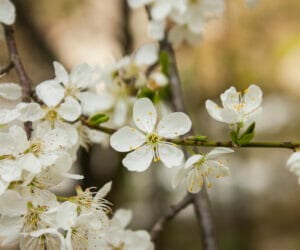 Portland, and the rest of the Pacific North West, are well known for their every lasting supply of cherries. In fact, the Pacific North West is one of the biggest producers and exporters of cherries in the entire world. Therefore, it’s safe to say that cherry trees not only can survive in Portland, but they almost always thrive with proper care. With over 1,000 varieties of edible cherry trees to pick from, it’s easy to see why they are one of the best fruit trees to grow in the Pacific North West.
Portland, and the rest of the Pacific North West, are well known for their every lasting supply of cherries. In fact, the Pacific North West is one of the biggest producers and exporters of cherries in the entire world. Therefore, it’s safe to say that cherry trees not only can survive in Portland, but they almost always thrive with proper care. With over 1,000 varieties of edible cherry trees to pick from, it’s easy to see why they are one of the best fruit trees to grow in the Pacific North West.
Cherry trees require little to no maintenance and offer the widest variety of flavors and colors. Homeowners who love tart cherries can plant types of cherry trees such as:
- Chokecherries
- Morello
- Montmorency
- Early Richmond
- Balaton
- Many More
Homeowners who wish to plant sweet cherry trees can choose from varieties such as:
- Bing
- Lambert
- Sweetheart
- Tulare
- Rainier
- Many More
Cherry trees do not pollinate themselves, therefore homeowners will need to plant two or three trees to ensure there is an adequate and productive bounty every year. They flower in the spring and produce their fruit a lot quicker than other fruit trees. Typically, the perfect picking season for cherries starts in early June and extends until late August.
4. Pear Trees
It’s hard to believe for those who do not live in Oregon, but the state fruit is actually the pear! In fact, around 84% of the pears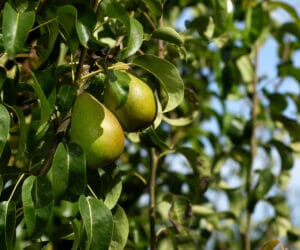 grown in the United States are produced in Oregon. The rich volcanic soil, warm days, and cool nights accompanied by plenty of water are the perfect climate and environment for pear trees to grow and be productive.
grown in the United States are produced in Oregon. The rich volcanic soil, warm days, and cool nights accompanied by plenty of water are the perfect climate and environment for pear trees to grow and be productive.
Pear trees are one of the earliest fruit trees to flower, as they begin to flower in late February until around the middle of April. However, they are also one of the latest fruits to ripen as they do not do so until August or September. They are also low-maintenance fruit trees, meaning they only need to be pruned around once a year.
Pear trees are self-pollinating, however, it is recommended that more than one pear tree be planted. This is to increase the chances of pollination, which will make the tree produce more fruit. The best varieties of pear trees to plant in Portland are:
- Anjou
- Bartlett
- Bosc
- Concorde
- Many More
5. Plum Trees
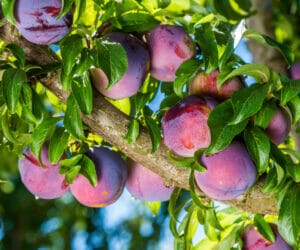 Plums are a very versatile fruit, and that is why so many Portland homeowners want to plant them in their yards. With over 400 varieties to choose from, a myriad of pastries and jams can be made with the fruit, and they make for the perfect on-the-go snack. Additionally, many homeowners love the robust colors that plums provide as they develop and begin to ripen on the tree. Deep purples accompanied by vibrant green leaves will boost the aesthetic of any home.
Plums are a very versatile fruit, and that is why so many Portland homeowners want to plant them in their yards. With over 400 varieties to choose from, a myriad of pastries and jams can be made with the fruit, and they make for the perfect on-the-go snack. Additionally, many homeowners love the robust colors that plums provide as they develop and begin to ripen on the tree. Deep purples accompanied by vibrant green leaves will boost the aesthetic of any home.
Plum trees are relatively easy to maintain, and they are extremely hardy trees. Unlike the other types of fruit trees previously mentioned, plum trees are brilliantly resistant to almost all insects and every disease. This makes it the perfect fruit tree for first-timers, as well as homeowners who want fruit trees that are little to no maintenance.
The best varieties of plum trees to plant in Portland are:
- Italian Prunes
- Empress
- Santa Rosa
- Shiro
- Many More
6. Crabapple Trees
Crabapple tree fruit is a fruit that is seldom talked about. Out of all the types of crabapple trees, the pacific crabapple is the only variety that is native to the Pacific North West. This small tree often looks like a shrub and produces oblong, round, and very tart fruit.
variety that is native to the Pacific North West. This small tree often looks like a shrub and produces oblong, round, and very tart fruit.
Crabapple trees are not for every homeowner. Those who wish to invite all local birds and wildlife into their yard are sure to attract a vast array when they have a crabapple tree present in their yards. Birds love to feast on crabapple fruits, as they provide a vast amount of nutrients. If a homeowner does not want an active bird population in their yard, they will want to refrain from planting a pacific crabapple tree.
Many homeowners choose to let the animals feast on the crabapple tree fruit. However, there are plenty of delicious things to make for human consumption. Crabapple pie, jam, and tarts are all a favorite of those who enjoy the unique taste of crabapples. Crabapple trees typically begin to fruit in the summer and are ripe by the fall, but the best time to harvest them is during winter. The freezing temperatures make the crabapple tree fruit softer and sweeter, which is perfect for cooking with them.
Fruit Tree Planting in Oregon
When should I plant fruit trees in Oregon?
Fruit trees, just like other trees, go through stages of dormancy in the colder months. In fact, all fruit trees in the Pacific North West go dormant when the weather changes from fall to winter. When a tree is dormant, it loses its leaves and begins to conserve energy to make it through the winter months without dying off. Therefore, it is best to plant trees when they are dormant.
The perfect time of year to plant fruit trees is in the early spring, while they are still dormant. This will allow them to transfer and easily settle into their new environment before they start to pollinate and produce fruit. The tree’s roots will have time to spread out and the spring weather will allow them to do this easily as the ground will not be frozen anymore. This will allow the fruit tree to start photosynthesis without any stressors like frigid weather, dry weather, or extreme heat.
If you are considering planting a fruit tree in Portland, Oregon, or need help with a current fruit tree on your property, we offer a number of services for our customers to help maintain and select trees.
Our Portland Fruit Tree Maintenance Reviews
“My trees are so happy! The arborists at Urban Forest Pro were knowledgeable, skilled, friendly, and efficient. I recently purchased a property with an old apple tree, large cedars, and some shrubs badly in need of pruning. One of my goals is to help these trees outlive me and I’m pretty confident that the work Urban Forest Pro did has set them on that course.The workers also performed a squirrel rescue! After their nest was disturbed, one of the guys found a baby squirrel hiding under my siding. He bravely and gently pulled it out by its tail and sent it scrambling on its way back up the cedar. Thank you for that act of kindness! Urban Forest Pro did a great job and I will definitely use them for my tree work in the future. Colette, SE Portland”
⭐⭐⭐⭐⭐ 5/5 Rating from Colette DeWitt on Google
“Urban Forest Pro is made up of wonderful folks…from the office greeters to the worker bees doing the tree work. Scaling up my massive false pear was no small feat. The crew not only trimmed her up beautifully but hauled away the evidence, down to the last leaf. Careful, thoughtful and efficient – I love those guys!!”
⭐⭐⭐⭐⭐ 5/5 Rating from Sharon Gaglia on Google
“The “Pros” at Urban Forest Pro were magnificent! This is our second year with this group, and everybody is fantastic. The home team schedules us in automatically, the crew who comes to prune our bartlett and asian pear trees are knowledgable and precise, and we’ve had the highest yield with our trees since Urban Forest Pro took over. I tell all of my friends about you guys, you’re the BEST!”
⭐⭐⭐⭐⭐ 5/5 Rating from Richard McConnell on Google
Find more of our reviews on Google here. We have a 4.8-star rating and 196+ reviews.
This post first appeared on https://www.urbanforestprofessionals.com